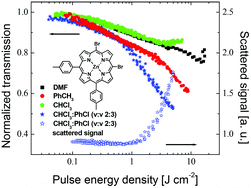Solvent effect on the nonlinear absorption of 5,10-A2B2meso substituted porphyrins†
Abstract
The effect of the

* Corresponding authors
a
School of Chemistry, SFI Tetrapyrrole Laboratory, Trinity Biomedical Sciences Institute, 152-160 Pearse Street, Dublin 2, Ireland
E-mail:
sengem@tcd.ie
Fax: +353 1 896 8536
Tel: +353 1 896 8537
b Key Laboratory of Materials for High Power Lasers, Shanghai Institute of Optics and Fine Mechanics, Chinese Academy of Science, 201800, Shanghai, China
c School of Physics, Trinity College Dublin, Dublin 2, Ireland
The effect of the

 Please wait while we load your content...
Something went wrong. Try again?
Please wait while we load your content...
Something went wrong. Try again?
M. Zawadzka, J. Wang, W. J. Blau and M. O. Senge, Photochem. Photobiol. Sci., 2013, 12, 1811 DOI: 10.1039/C3PP50156F
To request permission to reproduce material from this article, please go to the Copyright Clearance Center request page.
If you are an author contributing to an RSC publication, you do not need to request permission provided correct acknowledgement is given.
If you are the author of this article, you do not need to request permission to reproduce figures and diagrams provided correct acknowledgement is given. If you want to reproduce the whole article in a third-party publication (excluding your thesis/dissertation for which permission is not required) please go to the Copyright Clearance Center request page.
Read more about how to correctly acknowledge RSC content.
 Fetching data from CrossRef.
Fetching data from CrossRef.
This may take some time to load.
Loading related content
